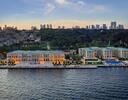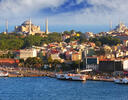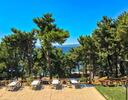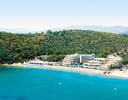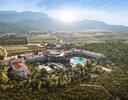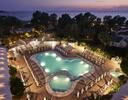Best of Turkey
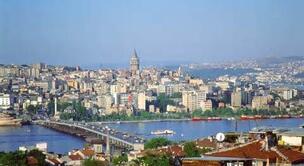
Intense, loveable, inventive, wondrous and spiritual. If Turkey was as famous celebrity, this is how its fans would describe it. But why depend on descriptions? Take an unforgettable journey to this beautiful Country !
Istanbul is hot. And we’re not talking about the weather. These days, there are more happening restaurants, bars, galleries and clubs around town than there are exquisite Ottoman mosques (and that’s a lot). The international fashion and design press have been talking up Istanbul adnauseam, but the most significant thing about the accolade ‘World’s Hippest City’ is that Istanbullus themselves have come believe it.
Those troglodytes sure knew what they were doing when they decided to lay down their hats and call Cappadocia home. Deep in the heart of the country, they settled within the lunar-like landscape and burrowed their houses and churches into stone cliffs and their cities underground. In so doing, they provided a still-cogent example of the simplicity and sense of living at one with nature rather than imposing upon it.
Turkey’s Eastern Mediterranean means different things to different people. For holidaying Europeans, it’s a radiant and razzle-dazzle beach paradise, with the calm ocean and high-rise resorts around Side and Alanya stretching further than the eye can see.
Come, visit this diverse land to fall in love with if forever !
Itinerary
- Day 1
Arrival Istanbul
Arrival at Istanbul airport, meet & greet by our representative, Transfer to Hotel for check in
This magical meeting place of East and West has more top-drawer attractions than it has minarets (and that's a lot).
Living History - ?stanbul's strategic location has attracted many marauding armies over the centuries. The Greeks, Romans and Venetians took turns ruling before the Ottomans stormed into town and decided to stay – physical reminders of their various tenures are found across the city. The fact that the city straddles two continents wasn't its only drawcard – it was the final stage on the legendary Silk Road linking Asia with Europe, and many merchants who came here liked it so much that they, too, decided to stay. In so doing, they gave the city a cultural diversity that it retains to this day.
Art & Architecture - The conquering armies of ancient times tended to ransack the city rather than endow it with artistic treasures, but all that changed with the Byzantines, who adorned their churches and palaces with mosaics and frescoes. Miraculously, many of these remain. Their successors, the Ottomans, were quick to launch an ambitious building program and the magnificently decorated imperial mosques that resulted are architectural triumphs that together form one of the world's great skylines. In recent years, local banks and business dynasties have reprised the Ottomans' grand ambitions and endowed an impressive array of galleries, museums and festivals for all to enjoy.
Culinary Heritage - 'But what about the food?' we hear you say. We're happy to report that the city's cuisine is as diverse as its heritage, and delicious to boot. Locals take their eating and drinking seriously – the restaurants here are the best in the country. You can eat aromatic Asian dishes or Italian classics if you so choose, but most visitors prefer to sample the succulent kebaps, flavoursome mezes and freshly caught fish that are the city's signature dishes, washing them down with the national drink, rak? (aniseed brandy), or a glass or two of locally produced wine.
Local Life - Some ancient cities are the sum of their monuments, but ?stanbul factors a lot more into the equation. Chief among its manifold attractions are the locals, who have an infectious love of life and generosity of spirit. This vibrant, inclusive and expanding community is full of people who work and party hard, treasure family and friendships, and have no problem melding tradition and modernity in their everyday lives. Joining them in their favourite haunts – çay bahçesis (tea gardens), kahvehans (coffeehouses), meyhanes (Turkish taverns) and kebapç?s (kebap restaurants) – will be a highlight of your visit.
After checked in & settled, day at leisure to explore the city on your own ... We recommend you to visit the Taksim Square to feel the pulse of city
Taksim Square is the most known modern city center of Istanbul. Many hotels and restaurants are in or near the Square and on Istiklal Street, and there is a local bus terminal for public transportation and the main subway station. Istiklal pedestrian street has many bars, night clubs and movie theaters therefore it's always busy with young people almost for 24 hours a day. The Square is also the meeting place to celebrate New Year's Eve, parades, public concerts and other shows.
The most important monument in Taksim Square is the Independence Monument (Istiklal Aniti in Turkish), standing at the beginning of Istiklal pedestrian street. This is also the turnaround point for the old tram which is the only vehicle permitted on Istiklal Street
Overnight at Istanbul - Day 2
Istanbul - Sightseeing
After breakfast at the hotel, day free for Istanbul sightseeing assisted by our guide
Visit the famous Spice Market, take a cruise along the Bosphorus, visit the Asian side of Istanbul, crossing the transcontinental Bosphorus Bridge, connecting Europe and Asia, and return to the hotel i nthe evening. Lunch on way.
Spice Market : Spice Market is one of the oldest bazaars in the city. Located in Eminönü, it is the second largest covered shopping complex after the Grand Bazaar. Due to the fact that many spices were imported via Egypt in the Ottoman period, the name was favoured by the public, The Spice Bazaar is definitely one of the most colourful locations in Istanbul. You can find just about anything in the Spice Bazaar including a wide variety of spices, colourful sweets, nuts and snacks that smell delightful and row upon row of dried fruits. In addition to being a must-see for local and foreign tourists, this historical marketplace is also a favourite shopping centre for residents of Istanbul.
Transfer to pier and take a cruise along the Bosphorus,
Bosphorus : Whether you take a traditional Istanbul ferryboat, or a smaller, faster TurYol or other boat, you're sure to enjoy a tour-cruise up the Bosphorus, You set out from the Eminönü ferryboat docks and head north toward the Black Sea, Here are the sights you'll see divided into two parts, the Southern Bosphorus and the Northern Bosphorus. Istanbul seen from the Bosphorus is an impressive and unforgettable cruising experience. Enjoy unique views with great photo opportunities in a relaxing environment with this sightseeing cruise gliding by some of the famous and historical sights of the Bosphorus Strait.
Asian side Of Istanbul : Kad?köy and Üsküdar forms the historical cores of this part of the city. Both started as cities independent of Istanbul and only incorporated into the city of Istanbul in late 19th century. It’s no coincidence that the regular steamer services across the Bosphorus was started a few years earlier. Oday Kad?köy and Üsküdar are mainly commercial zones. The rest of this part of the city mainly consist of soulless suburbs full of quite high-rise apartment blocks, most of which date back no more than 30 years Major exceptions are the Bosphorus bank, with its historical palaces, mansions, and neighborhoods with a character; and the coast of the Sea of Marmara, all along which lies a lovely park on the edge of which a number of impressive wooden mansion lie.
Bosphorus Bridge : The Bosphorus Bridge also known as the First Bosphorus Bridge, is a suspension bridge in Istanbul spanning the Bosphorus Strait. The bridge is located between Ortakoy (on the European side) and Beylerbeyi (on the Asian side). It is a gravity anchored suspension bridge with steel pylons and inclined hangars. The aerodynamic deck is hanging on zigzag steel cables. The decision to build a bridge across the Bosphorus Strait was made in 1957. Construction on the Bosphorus Bridge started on February 1970 and the bridge opened on October 30, 1973.
Evening at leisure
Overnight at Istanbul - Day 3
Istanbul - Sightseeing
After breakfast, day free for Istanbul Sightseeing covering the highlights today
Chance to visit and discover Byzantine and Ottoman treasures. Enjoy the wonders of the Hippodrome Square, Hagia Sophia Museum, the Blue Mosque, the Royal Topkapi Palace and the historical Grand Bazaar. Lunch on way. Back to hotel in the evening
Discover Byzantine : The Küçükyal Arkeopark, a large archaeological area on the Asian side of Istanbul, hosts the only surviving Byzantine monastic complex in the city.
Ottoman Treasures : The Ottoman Treasury is made by Felix Hönings. From the standpoint of art and history the exibition The Ottoman Treasury has its own unique value. The most famous treasuries in the world, some never seen for centuries painstakingly remakes of illustrous crowns, tiara´s, maces and pendants which never have or will be exibited. If the diamonds, emeralds, rubies, brilliant's, chrysolite, and turquoises would be real, no insurance-company could place a price on their worth. Thanks to keen lightning these immitation gems sparkling like a bouquet of light. A visitor is unable to prevent himself from being caught up in the memories of an overwhelming past.
Hippodrome Square : The Hippodrome of Constantinople was a circus that was the sporting and social centre of Constantinople, capital of the Byzantine Empire. Today it is a square named Sultanahmet Meydan in the Turkish city of Istanbul, with only a few fragments of the original structure surviving. It is sometimes also called Atmeydan in Turkish. The word hippodrome comes from the Greek hippos, horse, and dromos, path or way. Horse racing and chariot racing were popular pastimes in the ancient world and hippodromes were common features of Greek cities in the Hellenistic, Roman and Byzantine eras.
Hagia Sophia Museum : Hagia Sophia is a former Orthodox patriarchal basilica, later a mosque, and now a museum in IstanbulnHagia Sophia is considered a unique monument in world architecture, and its magnificence and functionality has been a good example in construction of countless Ottoman mosques. Hagia Sophia with its exceptional history constitutes a synthesis between east and west. This monument is one of the wonders of the world that has remained intact until the present day.
The Blue Mosque : The Blue Mosque was commissioned by Sultan Ahmet I when he was only 19 years old. It was built near the Hagia Sophia, over the site of the ancient hippodrome and Byzantine imperial palace (whose mosaics can be seen in the nearby Mosaic Museum). Construction work began in 1609 and took seven years. The mosque was designed by architect Mehmet Aga, whose unfortunate predecessor was found wanting and executed. Sultan Ahmet was so anxious for his magnificent creation to be completed that he often assisted in the work.
The Royal Topkapi Palace : The Topkapi Palace is one of the most significant tourist attractions of Istanbul and one of the most visited museums of Turkey. For over 400 years this palace served as government headquarters of the Ottoman Empire, one of the three largest empires in the world's history. In 1453, after Istanbul was conquered by the Turks, the Ottoman Padihah Sultan Mehmed, settled in a small palace near contemporary Kapali Çarsi, and ordered (1457-1478) the construction of the most important buildings of the Topkapi Palace on top of the ruins of a ancient Roman city. During the following centuries, and all the way to the 19th century the palace was constantly being built, modernized, and enriched.
The Historical Grand Bazaar : The grand bazaar began construction in 1455 and opened in 1461. It is well known for its jewelry, pottery, spice, and carpet shops. Many of the stalls in the bazaar are grouped by the type of goods, with special areas for leather coats, gold jewelry and the like. The bazaar was vastly enlarged in the 16th century, during the reign of Sultan Suleiman the Magnificent, and in 1894 underwent a major restoration following an earthquake. Today, the grand bazaar houses two mosques, two hamams, four fountains, and multiple restaurants and cafes. The sprawling complex consists of 12 major buildings and has 22 doors.
Overnight at Istanbul - Day 4
Istanbul - Ankara - Cappadocia
After breakfast, transfer to Istanbul airport for your flight to Ankara
Turkey's 'other' city may not have showy Ottoman palaces or regal facades, but Ankara thrums to a vivacious, youthful beat unmarred by the tug of history. Drawing comparisons with ?stanbul is pointless – the flat, modest surroundings are hardly the stuff of national poetry – but the civic success of this dynamic city is assured thanks to student panache and foreign-embassy intrigue.
The country's capital has made remarkable progress from a dusty Anatolian backwater to today's sophisticated arena for international affairs. Turkey's economic success is reflected in the booming restaurant scene around Kavakdere and the ripped-jean politik of Kzlay's sidewalk cafes, frequented by hip students, old-timers and businessmen alike. And while the vibrant street life is enough of a reason to visit, Ankara also boasts two extraordinary monuments central to the Turkish story – the beautifully conceived Museum of Anatolian Civilisations and the Ant Kabir, a colossal tribute to Atatürk, modern Turkey's founder.
Visit the Anatolian Civilizations Museum - The Museum of Anatolian Civilizations (Turkish: Anadolu Medeniyetleri Müzesi) is located on the south side of Ankara Castle in the Atpazar? area in Ankara,
The exhibits of gold, silver, glass, marble and bronze works date back as far as the second half of the first millennium BC. The coin collections, with examples ranging from the first minted money to modern times, represent the museum's rare cultural treasures.
Collection starts with the Paleolithic era, and continue chronologically through the Neolithic, Early Bronze, Assyrian trading colonies, Hittite, Phrygian, Urartian, Greek, Hellenistic, Roman, Byzantine, Seljuq and Ottoman periods.
After lunch, continue to Cappadocia by road ... 340 kms., 4 hrs. drive
As if plucked from a whimsical fairytale and set down upon the stark Anatolian plains, Cappadocia is a geological oddity of honeycombed hills and towering boulders of otherworldly beauty. The fantastical topography is matched by the human history here. People have long utilised the region's soft stone, seeking shelter underground and leaving the countryside scattered with fascinating cavern architecture. The fresco-adorned rock-cut churches of Göreme Open-Air Museum and the subterranean refuges of Derinkuyu and Kaymakl? are the most famous sights, while simply bedding down in one of Cappadocia's cave hotels is an experience in 21st-century cave living.
Whether you're wooed here by the hiking potential, the history or the bragging rights of becoming a modern troglodyte for a night, it's the lunarscape panoramas that you'll remember. This region's accordion-ridged valleys, shaded in a palette of dusky orange and cream, are an epiphany of a landscape – the stuff of psychedelic daydreams.
On arrival check in at hotel ... Evening at leisure
Dinner at hotel and overnight at Cappadocia - Day 5
Cappadocia - Sightseeing
After breakfast, depart on a tour discovering Cappadocia assisted by our guide
Unusual space land, the fairy chimneys, troglodyte dwellings and underground cities built by Christians in the 7th century. Visit the Goreme Valley, Zelve, Uchisar and the underground city of Kaymakli.
Visit the panoramic Pigeon Valley where pigeons contributed to the lives of locals with their manure to fertilize the wineyards. You may also like to taste Cappadocia wine in a local winery
Star with a stop to take photos at Uc Guzeller which are famed fairy chimneys in Cappadocia.
Next, visit to Devrent Valley has various types of fairy chimneys. Among these are those with caps, cones, mushroom like forms pillar and pointed rocks.We will take a walk through this amazing valley.
Then, you will visit Pasabaglari (Monk’s Valley) where you will see many fairy chimneys with multiple stems and caps can be found here, this style being unique to this area. A chapel dedicated to St. Simeon and a hermit's shelter is built into one such fairy chimney with three heads.
After visiting Pasabag, we will drive to Avanos which is known for the pottery, a craft dating back to the Hittite period. The red clay which is worked by local craftsmen comes from the residue in the Kizilirmak river. The Kizilirmak, which divides Avanos into two, is Anatolia's longest river.
Bit of a break on way for some rest & lunch at a local restaurant.
After lunch, we will proceed to Goreme Open Air Museum where this religious education started. You will visit the churhces, chapels and monasteries carved into the fairy chimmeys from the 10th to the 13th centuries with frescos painted on the walls.
Before we take you to your hotels, we will have a rest to take some photos in Uchisar Castle and Esentepe. Uchisar Castle is the highest point in the region. The castle and its surroundings used to be the most populated area of this settlement. As for Esentepe, this hill provides a magnificent panorama of the surrounding area.
Dinner at hotel & overnight at Cappadocia - Day 6
Cappadocia - Konya - Pamukkale
After breakfast, drive to Konya ... 270 kms. - 3.5 hrs. drive
On way to Konya, visit to the 13th century Seljukian masterpiece Sultanhan Caravanserai ... The Sultanhani on the road between Konya and Aksaray is the largest caravanserai in Turkey, enclosing 4,900 square meters. Commissioned in 1229 by Sultan Alaeddin Keykubad I, it was built by the architect Muhammet of Syria. As one of the Sultan's Han, the building is a caravanserai with palatial aspects. Incorporated into the plan is a large courtyard with a two- story masjid in the center, a monumental covered hall, and a hammam (bath).
Continue drive to Konya
An economic powerhouse that is religiously inspired and a busy university city that's as conservative as they come: Konya treads a delicate path between its historical significance as the home town of the whirling dervish orders and a bastion of Seljuk culture, and its modern importance as an economic boom town. The city derives considerable charm from this juxtaposition of old and new. Ancient mosques and the maze-like market district rub up against contemporary Konya around Alaaddin Tepesi, where hip-looking university students talk religion and politics in the tea gardens. If you are passing through this region, say from the coast to Cappadocia, then make time to explore one of Turkey's most compelling cities.
Lunch on arrival at Konya.
At Konya, visit the Mausoleum of Mevlana, the world-wide famous mystic, proceed to Karatay Theological School in which beautiful tiles are on display.
Later continue to Pamukkale ... 390 kms. - 5 hrs. drive
Pamukkale has been made eternally famous by the gleaming white calcite travertines (terraces) overrunning with warm, mineral-rich waters on the mountain above the village – the so-called ‘Cotton Castle' (pamuk means 'cotton' in Turkish). Just above the travertines lies Hierapolis, once a Roman and Byzantine spa city, which has considerable ruins and a museum.
Unesco World Heritage status has brought measures to protect the glistening bluffs, and put paid to the days of freely traipsing around, but walking down the travertines remain one of Turkey’s singular experiences.
While the photogenic travertines get busloads of day-trippers passing through for a quick soak and photo op, staying overnight allows you to visit the site at sunset and dodge some of the crowds. This also gives time for a day trip to the beautiful and little-visited ancient ruins of Afrodisias and Laodicea, and to appreciate the village of Pamukkale itself.
On arrival check in at hotel
Dinner at hotel & overnight at Pamukkale - Day 7
Pamukkale - Aphrodisias - Kusadasi
After breakfast, morning tour of the the famed Cotton Castle Pamukkale, covering the ancient city of Hierapolis and the scenic village of Karahayit. Enjoy postcard-perfect views of sparkling white travertine pools. Enjoy the warm mineral waters of Pamukkale, formed by tons of limestone deposits.
Later drive to Aphrodisias, one of the most beautiful ancient cities in Turkey ... 100 kms. / 1 hr. 20 mins. drive
Added to Unesco's World Heritage List in 2017, this remote site in the Anatolian hinterland trumps many of Turkey's ancient sites for its sheer scale and lush surrounds (Roman poplars, green fields and warbling birds). It also has an impressive on-site museum housing sculptures and friezes excavated on site. Highlights include the marble reliefs in the museum's Sevgi Gönül Salonu, the Temple of Aphrodite, the white marble theatre and the stunning, overgrown, 270m-long stadium with its 30,000 seats.
Audio guides – a worthwhile investment – are available for ?10. The site is relatively untended, with some side paths disappearing into thickets and bramble, and with luck you could have it almost to yourself, creating the exotic feel of discovering lost ruins. The site is an easy detour for those driving between Pamukkale and the Aegean coast, and can be visited by guided tour from Pamukkale and other towns and cities in the region. If driving, you'll need to leave your car in the car park on the opposite side of the highway and get to the site on the dinky tractor shuttle provided.
Later drive to Kusadasi ... 160 kms., 2 hrs. drive
Kuadasi is a popular package-tour destination and, as the coastal gateway to Ephesus, Turkey's busiest cruise port. Lacking the sights and ambience of Bodrum and the mix of Marmaris, Kusadasi remains a runner-up on the Aegean party scene, but the Irish pubs, discos and multilingual touts certainly create a memorably ribald atmosphere. If you prefer to mix your Ephesus visit with nightlife and sea views rather than the rural ambience of Selçuk, then Kusadasi could be the right choice, offering some good hotels and restaurants.
On arrival check in at hotel
Rest of the day at leisure
Dinner at hotel & overnight at Kusadasi - Day 8
Kusadasi - Sightseeing
After breakfast, visit the Ionian city of Ephesus from the 1st century BC ... 20 kms.
Of Turkey's hundreds of ancient cities and classical ruins, Ephesus is the grandest and best preserved. A Unesco-listed World Heritage Site, it's the best place in the Mediterranean to get a feel for what life was like in ancient times. Ancient Ephesus was a great trading city and a centre for the cult of Cybele, the Anatolian fertility goddess.
Under the influence of the Ionians, Cybele became Artemis, the virgin goddess of the hunt and the moon, and a fabulous temple was built in her honour. When the Romans took over, Artemis became Diana and Ephesus became the Roman provincial capital, the fourth largest city in the empire after Rome, Alexandria and Antioch.
In 356 BC, the Temple of Cybele/Artemis was destroyed in a fire set by a lunatic called Herostratus, who claimed to have done it to get his 15 minutes of fame, proving that modern society has no monopoly on a perverted sense of celebrity. The Ephesians set to work building a grand new temple which, when finished, was recognised as one of the Seven Wonders of the Ancient World.
Continue to visit the Basilica of St. John and the House of the Virgin Mary, where she spent her final days
Dinner & overnight at Kusadasi - Day 9
Kusadasi - Izmir - Bergama - Canakkale
After breakfast, drive to Izmir ... 100 kms. / 1 hr. 20 mins.
Turkey's third-largest city is proudly liberal and deeply cultured. Garlanded around the azure-blue Bay of Izmir, it has been an important Aegean port since ancient times, when it was the Greek city of Smyrna, and its seafront kordon (promenade) is as fetching and lively as any in the world.
The city's rich and fascinating heritage reflects the fact that it has been the home of Greeks, Armenians, Jews, Levantines and Turks over the centuries. While not as multicultural these days, it still has resident Jewish and Levantine communities and its unique and delicious cuisine attests to this.
Foreign visitors here are largely limited to business travellers and tourists en route to Ephesus. The reason for this is a mystery to us, as the city is home to compelling attractions including one of Turkey's most fascinating bazaars, an impressive museum of history and art, and a local lifestyle as laid-back as it is welcoming.
Continue journey to Bergama [110 kms. / 1 hr. 30 mins. drive] and visit the Greco Roman city built on four rising terraces and the Asclepion
The laid-back market town of Bergama is the modern successor to the once-powerful ancient city of Pergamum. Unlike Ephesus, which heaves with tourists year-round, Pergamum is for the most part a site of quiet classical splendour. Its ruins – especially the Asklepion and Acropolis – are so extraordinary that they were inscribed on Unesco’s World Heritage List in June 2014, the 999th site in the world (and the 14th in Turkey) to be so honoured.
Later continue drive to Canakkale ... 220 kms., 3 hrs. drive
If you thought Çanakkale was worth visiting only as a launching point for Gallipoli's battlefields, think again. The presence of the highly regarded Çanakkale Onsekiz Mart University endows this small city with a sizeable student population that loves nothing more than to eat, drink and party in the atmospheric cobbled lanes around the saat kulesi (clock tower; 1897) and along the sweeping kordon (waterfront promenade). Joining their revelries is a highlight of any visit.
The undisputed hub of the region, Çanakkale is replete with mythological associations. It was from the ancient town of Abydos immediately north that Leander swam across the Hellespont every night to see his love, Hero; and it was in the Dardanelles that Helle, the daughter of Athamas, was drowned in the legend of the Golden Fleece, giving the waterway its ancient name. Close by are the remnants of ancient Troy, immortalised by Homer in his epic poem the Iliad.
On arrival check in at hotel
Dinner at hotel & overnight in Canakkale - Day 10
Canakkale - Troy - Istanbul
After breakfast, drive to Troy, the legendary town in the Iliad of Homer, the site of the Trojan Wars ... 70 kms. / 1 hr. drive
While not the most dramatic of Turkey's ancient sites, Troy is testament to the importance of myth to the human experience. Some imagination is needed to reconstruct the city's former splendour, but a decent guide will quickly bring to life the place that set the scene for Homer's Iliad. Troy is a popular destination for weekending school parties; try to visit mid-week.
Later cross the Dardanelles by ferry to Eceabat ... From here drive to Istanbul - 340 kms. / 4 hrs. 30 mins. drive
On arrival check in at hotel ...Evening at leisure
Overnight in Istanbul - Day 11
Departure Istanbul
After breakfast, morning at leisure
Later, transfer to airport for onward flight
Notes
Round the Year Destination ... Suggested extention - Greece
Hotels
Tour Inclusions [Turkey]
-
3 nights Istanbul
-
2 nights Cappadocia
-
1 night Pamukkale
-
2 nights Kusadasi
-
1 night Canakkale
-
1 night Istanbul
-
Sightseeing as per Itinerary
-
Daily breakfasts, 9 lunches and 6 dinners
-
All transfers and excursions throughout the program
-
English speaking professional local guide during the excursions
- Entrance fees for the museums mentioned in the program
-
Regular boat tour on the Bosphorus
Notes on itinerary
All our itineraries are "Just for Ideas" ... We will get to know you and customise an itinerary just for you that matches your requirements ... dates of travel, category of hotels, preferred airline, flexibility in choosing sightseeing, mode of travel between cities, etc.
Many of our clients have us design more relaxing, slower paced holidays with more in-depth experiences whereas some simply want to visit various destinations and cover only the highlights.
Together, we will determine the ideal route, pace of travel, accommodations, levels of pampering, style of touring, sightseeing to be included, dining preferences, adventure levels, options to meet locals, dates of travel & much more ! and based on this arrive at a price.
Do feel free to get in touch with us by a quick call on +91 79 29602961 or a short mail on mail@destinations4india.com ... Looking forward




